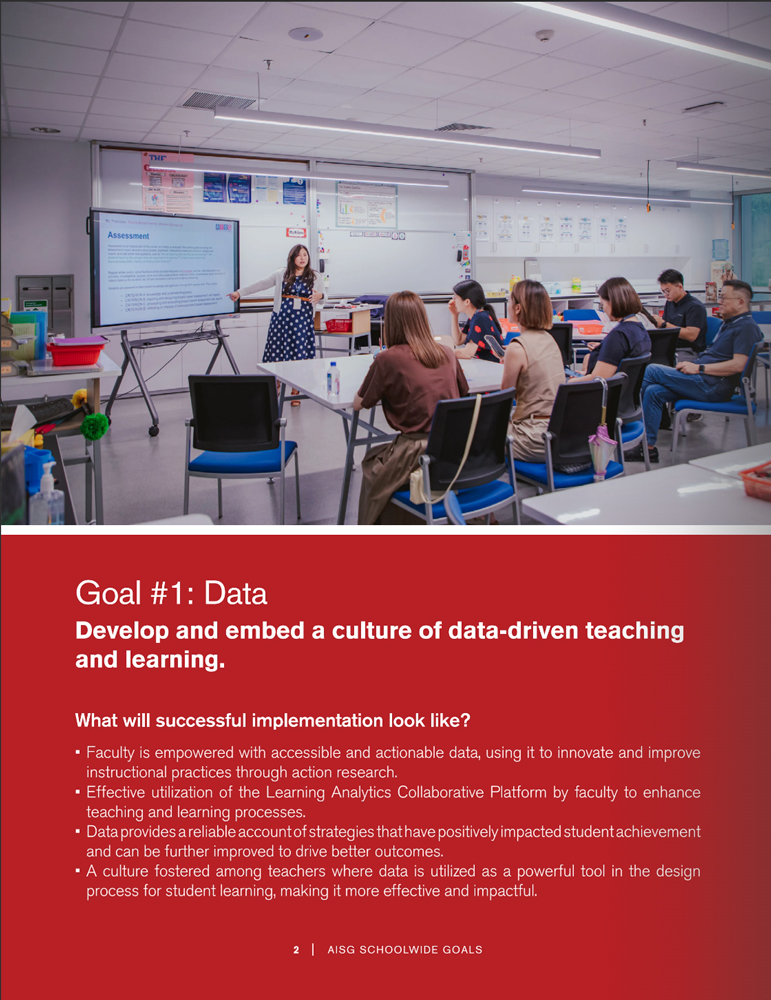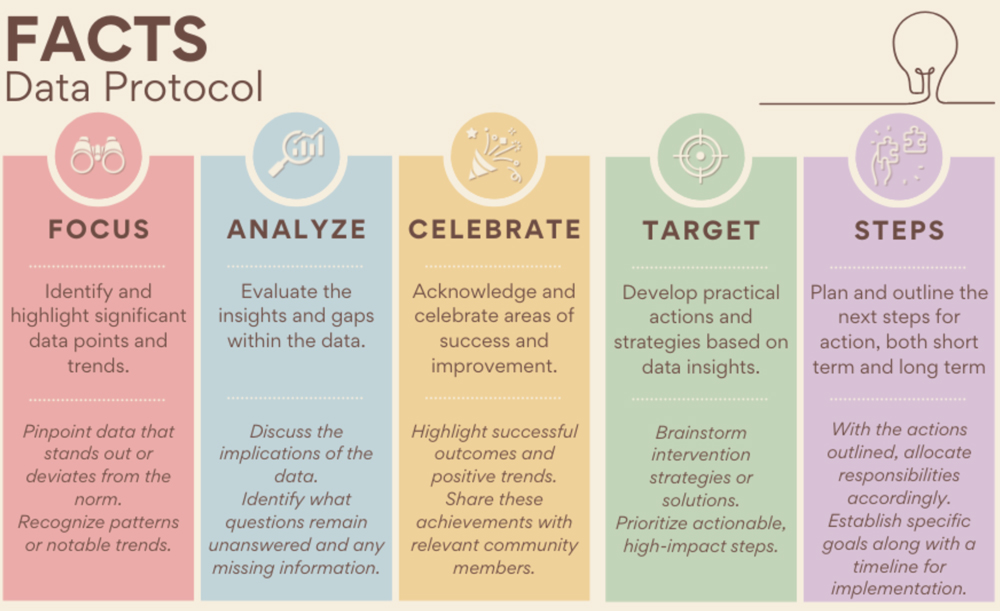
At the American International School of Guangzhou (AISG) in southern China, building a data culture is a goal shared across both campuses, serving more than 1,000 students from pre-K through high school. Embedding a data-driven culture of teaching and learning tops the list of the school’s six strategic goals..
It has taken time for the school’s commitment to data to take hold. AISG leaders can identify key decisions that have accelerated and sustained the school’s data journey, which could benefit other schools on similar paths.
Starting with a Goal
Deputy Director Jamie Robb says the journey began about five years ago with an end goal in mind. “We wanted to have data at classroom teachers’ fingertips,” he recalls, "so that they could see trends and make better-informed decisions to support student learning.”
Like most schools, AISG is not short of data. “We’re data rich,” Robb says, but until the information was organized and accessible, “we were not able to do deep dives—or even decide what we wanted to do deep dives on.”
Although the Covid pandemic slowed the data journey temporarily, post-Covid years have seen steady progress.
Recruiting Champions
AISG renewed its commitment to building a data culture when it hired a Learning Technology and Data Coordinator in 2023. Tim Evans brings a background in technology integration, giving him what he describes as “a lens for looking at how technology can support teaching and learning.” He spent his first months getting familiar with the school, “learning what was in place and looking for opportunities for growth or improvement,” he recalls.
Evans is also a key point of contact with the Learning Analytics Collaborative (LAC), ensuring that data uploaded to the school’s LAC platform is clean, accessible, and timely. That creates efficiencies for busy staff, “who don’t lose time looking for data,” says Robb. Evans also chooses which engines and visualizations to include and how to customize them to meet the school’s needs.
During his second year at AISG, Evans reached out to professional learning communities to recruit “digital champions” from across the faculty. Champions provide an informal network to raise questions from teachers and share resources back to colleagues. “We want to have teachers supporting teachers,” Evans explains, rather than creating a top-down structure for data and technology use.
Using data to improve teaching and learning takes time and practice. Evans pays attention to what he calls “aha! moments,” when teachers can see how data adds value in the classroom. In a recent discussion with a group of elementary teachers, they used a simple discussion protocol and data visualization to analyze external assessment scores. “They could see the purpose,” Evans says, and began sharing ideas for follow-up.
In addition to bringing data into just-in-time discussions, faculty also take part in data days scheduled throughout the year to inform planning and reflection.
Teacher buy-in doesn’t happen automatically. “Teachers need time to explore for this to become the norm,” Evans says. When introducing data tools to teachers, he makes sure that the information is accessible and up to date. The system needs to work smoothly so that no one is frustrated. “You’ve got to get it right,” he says, or busy teachers will lose interest.
As a next step in building the culture, Evans is working with digital champions to develop a schoolwide protocol for looking at data, ensuring a common vocabulary and shared purpose throughout the school. Involving teachers on protocol design “builds empowerment,” Evans says. “It says this is what we, as a community, feel is important. It meets our needs.”

Data in Action
When data discussions work well, participants emerge with deeper insights and a plan of action for follow-up.
Ralph Emmerink arrived at AISG in the fall of 2022 as a social studies teacher. He soon realized that “data was more on the forefront here” than in his previous international schools. “Like most teachers, I was used to data meaning: look at grades to see who’s underperforming, who’s overperforming, and how do we differentiate.”
He saw how data could be used more strategically when he and fellow social studies teachers looked closely at students’ reflective thinking. Qualitative data, based on teachers’ observations and conversations with students, revealed that most students did not reflect deeply. They tended to describe what they did rather than analyzing what they had learned or how they could grow. “We wanted to really hone in on that,” Emmerink recalls, and introduce classroom practices to deepen reflection.
Now in his third year at AISG, Emmerink has taken on a new role as Middle Years Programme (MYP) coordinator. Data is part of regular conversations with colleagues, “not daily but at least weekly.” He sees teacher buy-in increase if the purpose—the why of using data—is clearly communicated. “If we're doing this, how does it help us? Are we using data to improve our own teaching? Will this help students become better at what they're doing? What are some key takeaways?”
Conversations include both quantitative and qualitative data and encompass both academic and non-academic metrics. “Data tells a lot of stories,” Emmerink notes.
One such story is about students’ sense of belonging. When Panorama surveys revealed a decline in students’ sense of belonging post-Covid, AISG leadership recognized that as a concern. “We want to build that sense of community back up,” Evans explains. In response, more social events, games, and other after-school activities have been added to the calendar. Teachers are brainstorming ways to give students more agency in the classroom. Social and emotional learning is getting more attention during advisory times.
Staff will watch for evidence of improvement in follow-up surveys, as well as in conversations with students “We hope to see that we are growing in that sense of belonging,” Evans says.
Advice to Share
Jamie Robb encourages schools that are just beginning their data journeys to start with a shared purpose. “What do you want to use data for? What is your why? Involve many people from your team in that discussion.”
With purpose in mind, then reach out to other schools, including members of LAC. “Find out how they are using data. What has been difficult for them? What’s working well? That will help you determine if this is a good fit for your school,” Robb says.
Questions to Consider
How might AISG’s data journey inform your school’s growth in use of data? Here are questions to consider:
Suzie Boss is a writer and global educational consultant who focuses on the power of teaching, learning, and storytelling to improve lives and transform communities. The author of a dozen books on project-based learning and other innovative practices, she is a regular contributor to Edutopia and an adviser to Consilience. A frequent conference presenter, she consults with schools around the world interested in shifting to a more student-centered approach to teaching and learning.
Jamie Robb began working in international education in 2010. Before moving into international education, Jamie held the position of School Effectiveness Lead in Ontario, Canada, working with administrators to build school/school board capacity in identifying strengths, and next steps in the school improvement process. Jamie has been an elementary, middle, and high school principal over the course of his 24 years of leadership. Internationally, he has served schools in Kuwait, Korea, Brazil, and now in Guangzhou, China. Jamie is currently finishing his fifth year as the Deputy Director of the American International School of Guangzhou.
Ralph Emmerink was destined to become a history teacher from a young age, instilled by his grandfather's vast collection of history books. As an educator, Ralph embraces project-based and inquiry-based learning to create an open, safe, and collaborative learning environment. Ralph's international career has led him from the Netherlands, to Mexico, to China. Currently, Ralph serves as the Middle Years Programme (MYP) Coordinator at the American International School in Guangzhou.
Tim Evans is the Learning Technologies and Data Coordinator at the American International School of Guangzhou, China. Holding a Masters in Educational Technology, Tim brings a wealth of expertise to his role, blending theoretical knowledge with practical application. He is passionate about using technology in the classroom to enhance the whole teaching and learning experience. Originally from Wales, United Kingdom, Tim has led digital change in his home country and internationally in Spain, in Hong Kong, and most recently the United Arab Emirates. With a profound appreciation for data-driven methodologies, Tim advocates for strategic data utilization to drive informed decision-making within educational institutions.